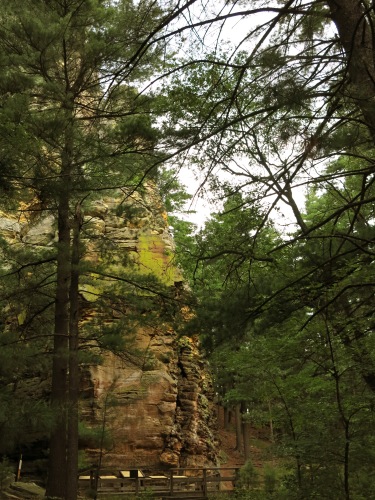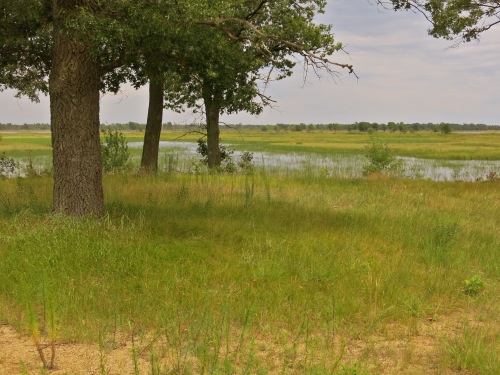I said my good-byes in Black Wolf, took one last look at the antenna I helped Ed put up over the past two days, and started driving west. After about an hour and a half of driving, I was ready for a break, so I drove a couple of miles south of U.S. 21 to Roche-A-Cri State Park. The main feature of the park is a 300 foot high sandstone formation, a mound known as Roche-A-Cri,” or crevice in the rock. This formation is mostly overgrown with trees, but in one place there is a dramatic sandstone cliff, weirdly weathered with petroglyphs at its base.

If this cliff were in Arizona or New Mexico, it would barely merit a glance, but it is in Wisconsin and thus it is strange and wonderful. I looked at the petroglyphs, left by ancestors of the Ho-Chunk people; I had passed the Ho-Chunk Nation casino earlier in the day. I climbed the 303 steps to the top of the mound, pausing half a dozen times on the way up to let my heart rate slow to normal. From the top, you can see for a long way across the flat plain of the Central Sands of Wisconsin, where there was once, thousands of years ago, a huge glacial lake. But it doesn’t look like much more than a flat tree-covered plain, so I headed back down.
By the time I climbed down the 303 steps and walked back to the parking lot at the entrance, it was time for lunch. While I was eating, three girls ran to play on the little playground there, and Tom, their grandfather, came over to chat with me. He told me about Necedah National Wildlife Refuge, half an hour down the highway, where Sandhill Cranes nest. So I decided to stop there.

The first thing I noticed about the refuge is that the soil is that same sandy soil I saw in Roche-A-Cri State Park; the soil of the Central Sands region. The next thing I noticed was the variety of plant communities within the refuge: I walked through woodlands and oak savanna and prairie and walked on boardwalks over marshland, all in the space of less than a mile.
It was the middle of the day, and most of the birds kept themselves far away. But I did see some Sandhill Cranes fly by, giving their loud rattling honking call; I saw a couple dozen White Pelicans glide over the marsh in the distance, their heads tucked back against their bodies, black wingtips barely moving as they soared in close formation. I saw a pair of Trumpeter Swans in the distance, distorted by the shimmer of heat rising from the marsh, with three or four cygnets swimming between them. Way off in the distance, I saw some sort of tall white long-legged wader; could it be some of the Whooping Cranes that have been re-introduced into Wisconsin? They were too far away for me to be sure.
Then, in the middle distance, flying low over the marsh, I saw some white birds with black wingtips flying along, but they weren’t pelicans for no pelican would fly with its neck outstretched, and no pelican would flap its wings like that; against all my expectations, I had just seen one of North America’s rarest and most dramatic birds, the Whooping Crane. True, I had only seen the birds at a distance, and only for a few short moments, but I had seen them; and the birds I had seen were part of a small population with a dramatic story: they have been re-introduced into the eastern half of the continent where they hadn’t lived in over a century, and they have had to be taught to migrate by following ultralight aircraft.
After seeing Whooping Cranes, the rest of the day was anti-climactic.
